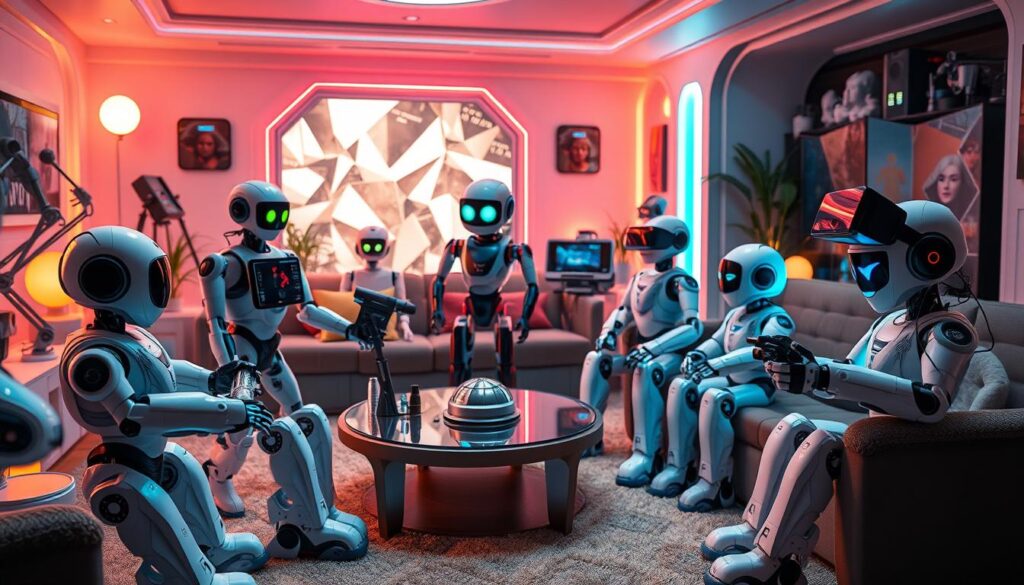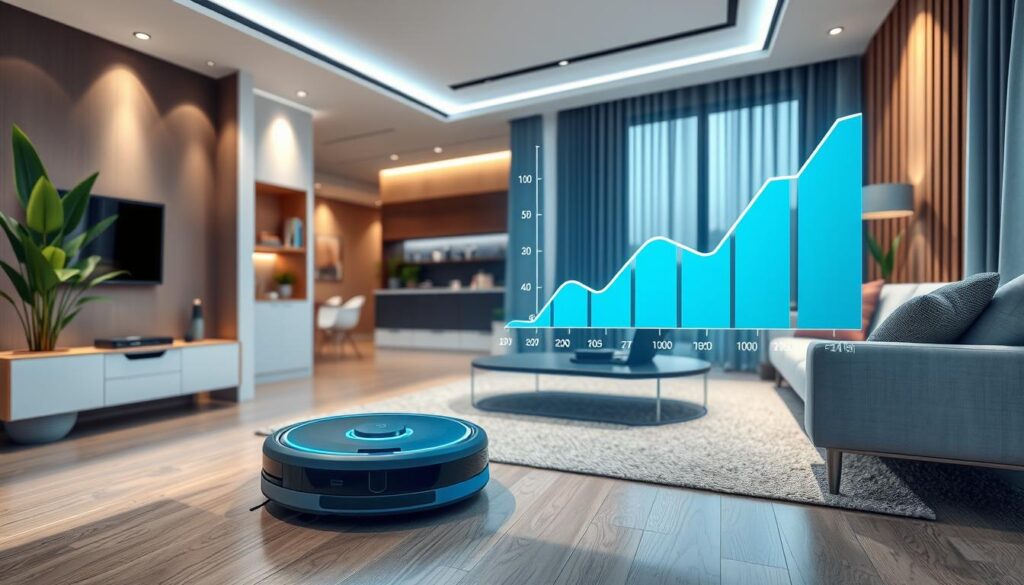The home robotics market in the United States is booming. It’s valued at $5.2 billion. Experts predict it will hit $11 billion by 2020, showing huge growth.
Home robots have been around since the 1990s. The first robot vacuum, Electrolux, came out in 2001. But, AI in these devices is a newer trend.
AI is making home robots smarter and more useful. It helps them understand voice commands and map homes on their own. This article will dive into how AI is changing home robots and what’s next.
Introduction to Home Robots and AI
The home robotics market has grown a lot in recent years. The service robot industry in the U.S. is now worth $5.2 billion, says the International Federation of Robotics. Home robots, or domestic robots, are expected to make $11 billion in revenue by 2020. This shows how important these AI-powered devices are becoming in our homes.
Overview of the Home Robotics Market
Home robots have been around since the 1990s. The first one was the 2001 Electrolux robot vacuum cleaner. It could only identify walls and avoid stairs with its sensors.
But in the last decade, these robots have gotten much better. Now, like the iRobot Roomba 980, they can map rooms, find obstacles, and remember the best ways to clean. This is all thanks to advanced AI.
Early Examples of Home Robots and Their Capabilities
- 2001 Electrolux robot vacuum cleaner with basic AI for wall and stair identification
- iRobot Roomba 980 with advanced AI for room mapping, obstacle detection, and route optimization
- Emergence of new home robots focused on social interaction and personalization
As the home robotics market grows, we’ll see even more advanced AI devices. They will help with cleaning, security, entertainment, and more. The future of home robots is exciting, with new tech in speech recognition, computer vision, and robotic manipulation.
Cleaning Robots
Artificial Intelligence (AI) has changed cleaning robots a lot. They can now do tasks better and more precisely. This includes everything from vacuuming to mowing lawns, thanks to AI.
Current AI Applications in Cleaning Robots
The Roomba 980 by iRobot is a top example. It uses AI for scanning rooms, finding obstacles, and mapping paths. This ensures a clean and organized space.
Sharp Corporation’s RX-V100 robot also uses AI. It can understand voice commands and tell you how it’s doing. This makes controlling the robot easy and convenient.
Bosch’s Roxxter robot vacuum cleaners use AI to map out their area. They can be controlled with voice commands, thanks to Amazon’s Alexa. Other big names like Dyson, Samsung, and Neato are also using AI to improve their cleaning robots.
| Brand | AI-Powered Features | Key Innovations |
|---|---|---|
| iRobot Roomba 980 | Room scanning, obstacle identification, efficient routing | Simultaneous localization and mapping (SLAM) technology |
| Sharp RX-V100 | Speech recognition AI engine, status reporting | Voice control and intelligent feedback |
| Bosch Roxxter | Interactive mapping, Alexa voice control | Smartphone integration and voice-activated cleaning |
These updates in AI in cleaning robots and robotic vacuum cleaners show how AI is changing home cleaning. It makes cleaning easier, more efficient, and more controlled for us.
Home robot development
The future of cleaning robots is looking bright and full of change. Companies are pouring money into AI research to make these robots better. In 2017, Honda showed off a robotic lawnmower called the Honda Ai-Miimo Concept. It’s an electric mower that talks to its owner using AI.
Dyson also made a big move in 2017. They spent $587 million on a tech center in Singapore. This center will focus on smart tech and machines.
AI research isn’t just for lawn mowers. OpenAI, a big AI group, wants to make a helpful robot for homes. Cleaning companies are working with AI tech to make better products. For example, Brain Corporation teamed up with SoftBank Robotics to create the ICE RS26 floor scrubber. It uses Brain Corp’s AI.
These efforts show a big push towards using AI in home robots. As AI research grows, we’ll see smarter cleaning robots. They will change how we keep our homes clean in the future.
Entertainment Robots
The entertainment world is getting a boost from AI and robotics. A 2017 report showed the market for entertainment robots grew a lot. It sold 2.5 million units, making $1.1 billion. Experts predict this market will hit $7.5 billion by 2020, growing 20%-25% each year.
Anki’s Cozmo is a great example of an entertainment robot. It has a big personality and can show many emotions. It uses AI, robotics, and computer vision for interactive play and face recognition. Emotech’s Olly is another example, a voice-controlled robot that understands emotions through computer vision and voice technology.
| Entertainment Robot | Key Features | Market Impact |
|---|---|---|
| Anki Cozmo | Deep AI, Robotics, Computer Vision | 2.5 million units sold in 2017, $1.1 billion revenue |
| Emotech Olly | Voice Control, Computer Vision, Emotion Recognition | Projected $7.5 billion market size by 2020, 20%-25% CAGR |
The use of entertainment robots in the entertainment world is growing fast. We see them in theme parks and Cirque du Soleil shows. As AI and robotics get better, we’ll see even more amazing entertainment.

Home Security and Surveillance Robots
The world of home security has changed a lot with AI. AI-powered cameras and robots are making homes safer. They offer features that go beyond what old security systems can do.
AI-Powered Home Security Cameras
BuddyGuard, a startup from Berlin, has created Flare. It’s an AI camera that can spot faces and hear strange sounds. It alerts you if it sees something suspicious, unlike Google’s Nest Cam.
Perimeter Security with AI
Deep Sentinel is an American company that uses AI for home security. They aim to stop crimes before they start. Their tech uses advanced learning to alert you early, making homes safer.
| AI Home Security Camera Features | AI Perimeter Security Features |
|---|---|
|
|
AI cameras and perimeter security show how AI can change home safety. They use new tech to give homeowners more security and peace of mind.
Adoption Trends and Market Outlook
The domestic robotics market is growing fast, thanks to advanced artificial intelligence (AI) technologies. Minnesota-based VC firm Loup Ventures says the robotic vacuum and robotic lawn mower markets will hit $2.6 billion and $1 billion by 2025. A Stanford report also predicts that AI will make domestic robots more popular by 2030.
The value of the household robot market is set to hit US$ 14.7 billion in 2024, with a 20.6% growth rate. By 2034, it’s expected to reach a huge US$ 96 billion. This growth is mainly due to the increasing demand for robotic vacuum cleaners, robotic lawn mowers, and other home automation solutions.
The top markets for household robots are the United States, Japan, the United Kingdom, South Korea, and China. The U.S. market is expected to reach US$ 17.1 billion by 2034, growing at 20.8% annually. The U.K. market is also growing fast, with a 21.2% CAGR, reaching US$ 4.1 billion by 2034. China and Japan are expected to see significant growth as well.

Domestic robots are not just for cleaning and lawn care anymore. The global service robotics market is set to grow from US$ 40.7 billion in 2023 to US$ 297 billion by 2033. The household robot segment is expected to grow even faster, from US$ 6.1 billion in 2023 to US$ 47 billion by 2033. This shows how AI is making household robots more versatile and appealing to consumers.
AI Governance and Privacy Concerns
As AI-powered home robots become more common, we need to create good AI governance. This will help manage AI use in homes and tackle privacy worries. The Stanford report notes that AI challenges like safety and scalability are harder than expected.
Data security is a big worry. AI is used in many important areas, like finance and health. It’s also used in social media, making it a target for hackers. Advanced AI algorithms can handle a lot of personal data, raising privacy concerns.
Mis/disinformation is another issue. AI can create fake content, making it hard to know what’s real. Bias and discrimination are also big concerns. AI can learn and show biases, leading to unfair treatment in areas like jobs and law enforcement.
AI is also used in areas like education and transportation. As AI in homes grows, we need strong governance and privacy protection. This will help ensure AI is used responsibly in our homes.
| Concern | Impact |
|---|---|
| Data Security | AI systems in critical infrastructure are vulnerable to cyber threats |
| Privacy | Advanced AI algorithms can collect and analyze personal data, leading to privacy violations |
| Mis/Disinformation | Misuse of AI can result in the spread of disinformation on a large scale |
| Bias and Discrimination | AI systems trained on biased datasets can perpetuate societal biases, leading to unfair outcomes |
Conclusion
Artificial intelligence (AI) and robotics are changing home automation and domestic tasks. AI in home robotics is growing, making our homes safer and more efficient. It’s making our lives easier.
There are still challenges, but new tech like computer vision and machine learning are helping. By 2030, AI robots will do even more for us. They can learn from us, making them better at helping in our homes.
The need for domestic robots is growing, especially for older people who want to stay at home. The future of home robotics future, AI in domestic robots, and smart home technology looks bright. It will make our lives better and boost the smart home industry.

